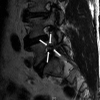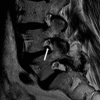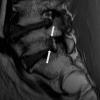Clinical correlation of a new MR imaging method for assessing lumbar foraminal stenosis
- PMID: 22241383
- PMCID: PMC7968829
- DOI: 10.3174/ajnr.A2870
Clinical correlation of a new MR imaging method for assessing lumbar foraminal stenosis
Abstract
Background and purpose: Recently, Lee et al reported a new grading system for the lumbar spinal foraminal stenosis. They considered the type of stenosis, the amount of fat obliteration, and the presence of nerve root compression. Our aim was to evaluate whether a new MR imaging grading system correlated with symptoms and neurologic signs and could replace the previous grading system.
Materials and methods: We examined 91 patients (M/F = 49:42; mean age, 50 years) who visited our institution and underwent MR imaging of the L-spine and were evaluated by 2 musculoskeletal radiologists. The presence and grade of lumbar foraminal stenosis at the maximal narrowing point was assessed according to the new grading system suggested by Lee et al (Lee system) and the Wildermuth grading system (Wildermuth system). Results were correlated with clinical manifestations and neurologic physical examination. Statistical analysis was performed by using κ statistics, categoric regression analysis, and nonparametric correlation analysis (Spearman correlation).
Results: Interobserver agreement in the grading of foraminal stenosis between the 2 readers was substantially correlated (κ of Lee system = 0.767, κ of Wildermuth system = 0.734). The Rs for reader 1 and reader 2 between the Lee system and the Wildermuth system were 0.880 and 0.885, between Lee system and PNM were 0.715 and 0.604, and between the Wildermuth system and PNM were 0.800 and 0.680. For patients younger than 50 years of age, the R between the Lee and Wildermuth systems was higher than that for patients 50 years or older, but the Rs between the grading system and PNM were lower in the younger group than in the older group. The Rs of the Wildermuth system with PNM were higher in the older group than in the younger group; the differences between the Rs of the Lee system with PNM and the Wildermuth system with PNM were higher in the older group (0.016 [young] versus 0.130 [old] and 0.008 versus 0.107).
Conclusions: Interobserver agreement of the Lee system was slightly higher than the Wildermuth system and substantially correlated. Both systems are good for evaluation of lumbar spinal foraminal stenosis, but the Lee system showed slightly better interobserver agreement and good clinical correlation in the younger group of patients.
Figures




References
-
- Attias N, Hayman A, Hipp JA, et al. . Assessment of MRI in the diagnosis of lumbar spine foraminal stenosis: a surgeon's perspective. J Spinal Discord Tech 2006;19:249–56 - PubMed
-
- Wildermuth S, Zanetti M, Duewell S, et al. . Lumbar spine: quantitive and qualitative assessment of positional (upright flexion and extension) MR imaging and myelography. Radiology 1998;207:391–98 - PubMed
-
- Lee S, Lee JW, Yeon JS, et al. . A practical MRI grading system for lumbar foraminal stenosis. AJR Am J Roentgenol 2010;194:1095–98 - PubMed
-
- Jenis LG, An HS, Gordin R. Foraminal stenosis of the lumbar spine: a review of 65 surgical cases. Am J Orthop (Belle Mead NJ) 2001;30:205–11 - PubMed
-
- Hasegawa T, An HS, Haughton VM, et al. . Lumbar foraminal stenosis: critical heights of the intervertebral discs and foramina: a cryomicrotome study in cadaver. J Bone Joint Surg Am 1995;77:32–38 - PubMed
MeSH terms
LinkOut - more resources
Full Text Sources
Medical
